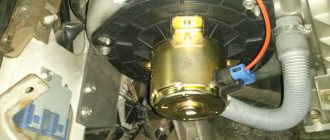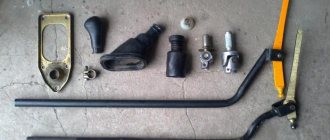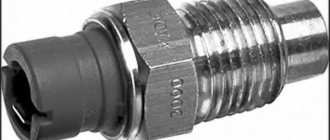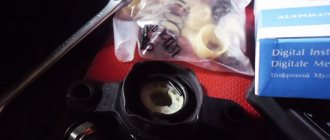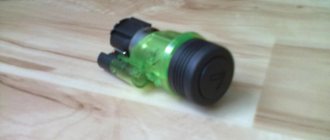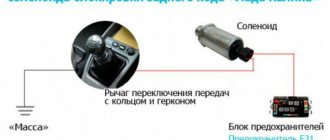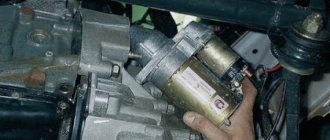What makes the gearbox on the Kalina noisy, what to do if the gearbox lever on the Lada Kalina 1 and 2 rings
The noise of the Kalina gearbox usually starts from the factory. This problem is caused by insufficiently precise machining of the gears - with a tolerance of 0.2 mm. In this case, noise or howling is heard only in a certain gear. Therefore, it is impossible to completely make the box silent; you can only reduce sound vibrations.
Lada Kalina of the 1st and 2nd generations has both manual and automatic transmissions. The box model depends on the engine size and the number of its valves. A common problem is that the gearbox on the Kalina (as well as on many other VAZ cars) is noisy.
Braking distance
Some drivers believe that emergency braking with the clutch and brake pedals depressed shortens the stopping distance of the car. In reality, with this braking mode, only the main braking system is activated. In this case, the adhesion of the tires to the road surface deteriorates, the wheels quickly lock, and the controllability of the vehicle is lost.
When braking with the gear engaged, the wheels do not lock, since the running engine does not allow this to happen. As a result, at any speed above 20 km/h, the braking distance is always shorter, and the driver does not lose control of the car.
How the gearbox works on Kalina
The gearbox on the Lada Kalina is a complex structure, the elements of which differ depending on the model and type of box.
Until 2013, Kalinas (first generation Kalina Sport, hatchback, station wagon, sedan) had a 5-speed manual transmission 1118, although in the last year (2013) it was possible to find cars with 2181 gearboxes with a cable drive. Gearbox 1118 is a transitional model, designed for torque up to 145 Newton/meter (Nm).
Gearbox "Lada Kalina", gearbox shafts
The second generation (“Kalina Sport”, hatchback, station wagon, cross) has a box 2180 (16-valve engines) and 2181 (8-valve engines).
Box 2181 consists of the following elements:
The first two gears are equipped with multi-cone synchronizers.
The design of the Lada robotic transmission (2182) is based on the 2180 transmission, but in this case the control is carried out by the system.
Gear shift lever for Lada Kalina
The mechanism is represented by the following components:
Gear shifting is carried out by electric motors and a gear selection and engagement drive.
The special feature of AMT is the electric drive of the clutch disc.
An automatic transmission, or automatic gearbox, is installed on the 2nd generation Lada Kalina with a 16-valve 1.6-liter engine. Simplified, the box mechanism can be represented as:
The automatic transmission has four stages and is manufactured by the Japanese company Jatco JF414E (AY-K3). Management is electronic. The operating mode of the box is selected by switching the lever to the desired position - P, R, D and N (parking, reverse, drive, neutral).
Box body with internal elements
Despite the fact that many drivers use the “neutral” mode to coast during a long descent, or hold the lever in this position when switching modes, the instructions for the automatic transmission do not recommend doing this. This is due to the fact that the engine is disconnected from the transmission in this mode, which allows the vehicle to be transported at low speed, but driving at high speeds can lead to breakage of the box, as well as the constant processes of disconnecting/attaching the engine to the box.
The design features a reduced ground clearance, as well as an aluminum pan that covers the engine. To avoid mechanical damage to the pallet, it is recommended that immediately after purchasing the car, replace it with a more durable one, for example, a steel one.
Roll on and don’t be capricious
Before the advent of the electronic era, cars did not have active trajectory correction systems and, when coasting, obeyed only the laws of inertia. At times, a direct connection between the wheels and the transmission was seen as the only way to maintain stability during emergency braking. Therefore, driving school instructors or simply experienced drivers always recommended driving in gear even on flat sections of roads. They also recommended performing the smooth deceleration process with the gear engaged, squeezing the clutch only before stopping.
The fact is that carburetor engines were capricious and often stalled when going to idle. While coasting, this could end in trouble, since the vacuum booster stopped working and the brake pedal turned to stone. Because of this, the intensity of braking dropped sharply. An inexperienced driver could lose control and get into an accident.
In addition, when the mechanical connection with the engine was broken, which always happens when the manual transmission is transferred to neutral speed, the car's wheels received excessive freedom. They rotated at will, and during emergency braking, any of the wheels could lock on a slippery or unsteady surface, resulting in loss of control. The car was flying at tremendous speed. To counteract such blocking during emergency braking, experienced people engaged third gear, using braking tactics along with the gas.
Why is the box noisy?
Gearbox noise is one of the unpleasant moments in operation, which is associated with design features. Owners note noise in the Kalina Cross, Sport, hatchback, and station wagon gearboxes when using box 2181. However, Kalina noise can also appear on an automatic transmission.
Oil too thick
If the gearbox on a Lada Kalina makes noise immediately after starting the engine, but the noise decreases while driving, the reason may be that the oil is too thick. However, fluids such as 85w90, for example, may be better than 75w80 precisely because of their increased viscosity, since they better fill the gaps between parts.
The thickness of the oil affects the occurrence of noise in the box.
Meanwhile, too thick oil makes it difficult for the gearbox to operate, especially when starting the engine.
Low oil level
One of the reasons for noise in the Kalina Cross, Sport, hatchback, and station wagon gearboxes, both with manual and automatic transmissions, is a low oil level. At the same time, “kicks” occur in the automatic transmission when changing gears.
To fix this, you can try adding oil to the box. However, it is difficult to check its level, since some models do not have a dipstick (on 2181). By unscrewing the oil filler plug, you can roughly determine the sufficiency of oil in the transmission - if it leaks, then there is enough oil, if not, then it is better to top it up.
In other models (2180, “Robot”, automatic transmission), the oil level can be checked with a dipstick and topped up to the required level, while only on the first two the procedure is carried out “cold”.
Worn bearings
On Kalina 1st and 2nd generations, noise in the gearbox may be from worn bearings of the primary and secondary shafts. When parts are replaced, the noise may decrease.
Checking the box bearings
It is possible to determine that the cause of the noise is a bearing without diagnostics, especially when it comes to the input shaft bearing. If the universal gearbox on a Kalina (2180) or another manual transmission makes noise when the selector is in neutral, then most likely it is the input shaft bearing.
But in neutral, the release bearing can also make noise. If this is the case, then when you press the clutch pedal (on a manual transmission), knocking, rattling, or other similar sounds begin to appear. If the input shaft bearing is faulty, if you depress the clutch pedal, the gearbox noise disappears, but when driving at speed (1st and 2nd gear), that is, at increased speeds, on the contrary, the noise turns into a howl.
The same applies to automatic transmission.
Hull damaged
The hum in the box appears due to damage to the housing. If the box on the 1st and 2nd generation Kalina is noisy when gears are freely changed (but with the possibility of some gears falling out) and there is virtually no oil in the box, then the likelihood of damage to the body increases. And if you drive with a “dry” gearbox, the risk of damage to the unit and the appearance of chatter (from faulty bearings) increases.
Do I need to depress the clutch? Do I need to put it in neutral?
Actually, where did all this come from? Coasting was invented by our grandfathers and great-grandfathers. In those days, engines were weak and unreliable, so it was necessary to regularly let them cool down - reduce the speed to idle, for which they turned on neutral. In addition, older cars saved fuel this way. It’s logical: lower engine speed means lower fuel consumption.
What about today? Today's engines are as reliable as nails and as healthy as oxen. They do not require additional cooling, especially such as turning on neutral, and are even designed for intensive work at high speeds.
Fuel economy
As for fuel consumption, there has been a forced idling mode for about 30 years now. Its essence is that when you release the gas pedal while the gear is in gear, fuel stops flowing into the engine, and consumption during deceleration is zero. Hard to believe? If the trip computer in your car can calculate instant fuel consumption, try it yourself and look at the fuel consumption readings during braking. You will see there nothing more than a zero without a stick. And when driving in neutral, the engine idles and consumes 1-2 liters of fuel per hour. It turns out that braking in gear with the gas released is more economical than in neutral or with the clutch pedal depressed. I cover the entire topic of economical driving in our school’s exclusive course “MBA course for drivers: Mastery of Car Driving.”
Reducing gearbox noise on Kalina
__________________
. and it all started with a moped.
__________________
. and it all started with a moped.
[quote=Vulkan;799774]Why so gloomy? It doesn't seem like tar was poured in. The oil in the engine works perhaps even under more difficult conditions than in the gearbox. Perhaps a more liquid consistency allows the iron to rub in? This guy drove Kalina for more than a year after that and nothing, the gearbox works fine. quote]
At least for starters, look for information about motor oils and transmission oils. This story about semi-synthetics has been in the box since it was difficult to get/buy good gear oil for our front-wheel drive cars. Now there are no problems with the purchase, but the bike is still alive. Here is a quote from the website of one oil manufacturer (I am not writing about the manufacturer so that there is no advertising):
| What transmission do you want? |
Any mechanism needs lubrication, but transmission units operate differently than engines. Parts in the motor slide against each other at high speed, which, if lubrication is disrupted, causes friction and accelerated wear. For gear teeth, the main problem is the pressure in the contact zone, which can reach enormous values, and damage to the teeth and wear of the gears become inevitable if, under the influence of this load, the oil is squeezed out of the mesh.
.
Differences in operating conditions determine the dissimilarity in the “characters” of motor and transmission oils.
The latter is required, first of all,
to maintain a strong oil film in the gear meshing zone in any operating conditions.
It would seem that it could be simpler - we fill the gearbox with something thicker and, since the higher the viscosity of the product, the stronger the oil film it creates, we provide the main requirement for gear oil. This, by the way, was nigrol - once the main “transmission” of all times and peoples. However, nigrol had to find a replacement due to its disgusting low-temperature properties. Nigrol worked well in the gearbox at temperatures of 50-90 degrees, but in order to reach this mode, the engine had to spend a certain amount of time up to half its power “shovelling” the frozen oil in the gearbox, main gear and differential. And in frosts of 15 degrees and below, it became problematic to even move a car with nigrol in the transmission.
Satisfactory viscosity can be ensured under a wide variety of temperature conditions while maintaining the lubricity of transmission oil by adding extreme pressure, antifriction and other additives to its base. This is done in modern oils, but as for the dosage of additives, one also has to take into account the design features of various transmission units.
The more extreme pressure additives the oil contains, the less likely it is that under extreme loads and the oil film thickness decreases to a critical value, the contacting gear teeth will not stick to each other, and their surfaces will be subjected to friction welding with subsequent tearing out pieces of metal from each other (experts This phenomenon is called pitting). However, extreme pressure additives, which are chemical compounds of sulfur, phosphorus and chlorine, are aggressive towards non-ferrous metals. It's time to remember that easy and shock-free gear shifting in manual transmissions is ensured by synchronizers, but these parts are precisely made of bronze or brass. Thus, if we overdo it in our desire to ensure the durability of the gears, we will lose due to accelerated wear and early failure of the synchronizers.
The situation is approximately the same with antifriction additives. The desire to reduce losses due to friction and wear is laudable, but it can complicate life for the same synchronizers, whose operation is based on semi-dry friction between the locking rings, which can ultimately cause difficulties when shifting gears, accompanied by damage to the gear teeth.
__________________ Lifan X60
, 1.8 v16 LUX package
I really want a power steering. To think complex thoughts without difficulty.
Source
Ball joint - knocking in the suspension of different characters
There is a part in the car suspension that is difficult to check. If it knocks, it happens precisely on small and unnoticeable irregularities. The ball loses its lubricant and begins to move very difficultly inside the seat. This causes sounds like creaking, light knocking, and annoying rattling. An element fails for the following reasons:
- just natural wear of the part, which occurs every 100,000 kilometers; during operation, the mechanism wears out, lubricant comes out, and efficiency decreases;
- the support begins to knock quite unexpectedly, the intensity of the sounds quickly increases, so it is better to promptly replace the element;
- when installing a low-quality support, a not very pleasant process occurs - after a few thousand kilometers, extraneous sounds appear that are unpleasant to listen to;
- Also, a torn boot is one of the main causes of problems in this part of the car, so you should constantly look at the rubber bands and their integrity.
The ball joint is very difficult to diagnose. To check it, it must be removed, which cannot be done without the help of a professional service. That is why they often do not sin on it when going through other suspension parts. It may well happen that you change half of the suspension until you get to the knock directly in the ball joint.
Which boxes howl?
The noise problem appeared after Auto VAZ introduced a manual transmission of its own production with a cable drive. These boxes pleased us with clearer gear shifting, but disappointed us with a rather loud howl, especially in 2nd and 3rd gears. The transmission that has this problem is manual transmission 2181.
Box 2181 is an improved previous model 2180. Instead of rigid rods, it is driven by a cable drive. Thanks to the reduction in the bevel of the synchronizer teeth, the gears began to engage more clearly. In 1-2 gears, conventional synchronizers were replaced with multi-cone synchronizers. It would seem that everything should be for the better, but as an unpleasant bonus to the easy gear shifting, buyers received an unpleasant soundtrack.
The plant received a large number of complaints from car owners, so in 2014 the manufacturer modernized the transmission. As AvtoVAZ assures, the updated version has become 25% quieter, but it is still far from ideal.
Extraneous sounds when coasting
Some motorists are seriously bothered by an incomprehensible hum when coasting. These alarming phenomena may have a different nature:
- Owners of all-wheel drive SUVs may be bothered by a knocking sound when coasting - this is the ringing of metal parts of auxiliary units designed to ensure high cross-country ability of the vehicle. All kinds of reduction gearboxes and drive mechanisms should be turned off when moving on regular roads.
- Noise when coasting can arise from air turbulence when the windows are open or from objects protruding beyond the aerodynamic dimensions of the car. We may also think that the sound coming from the tire treads, which we cannot hear during normal engine operation, is abnormal.
- Experienced drivers specifically listen to the hum when coasting to determine engine or transmission malfunctions. Modern cars cannot be checked in this way; if you suspect a breakdown, you need to immediately go to a car service center for professional diagnostics.
- The cause of the hum when coasting may be a worn-out wheel bearing.
- Body tuning of a car noticeably increases noise when coasting, and modifications to the chassis will add a lot of unnecessary noise to the overall sound picture.
- An unusual knocking sound when coasting may indicate loose interior trim, tools, or additional acoustic equipment.
Reasons for howling boxes on Lada Granta, Kalina and Vesta
The howl of the box usually appears already in the first thousand kilometers; the appearance of the noise is not affected by the operating conditions of the car. It follows from this that the problem is related to the design features of this unit.
The manufacturer assures that the cause of third-party sounds is imperfect processing of the gears, as well as the main pair. Minor roughness leads to the appearance of characteristic sounds when moving. In the modified version of the manual transmission, this problem is partially eliminated, but it is impossible to completely get rid of the hum, since the equipment available at the factory does not allow the parts to be brought to ideal condition.
Perhaps the plant will eventually update the equipment and delight its customers with an updated, quieter transmission; it is unknown when this will happen. Therefore, for now, all that remains is to put up with the hum of the box or try in action ways to reduce the sound while driving.
Extraneous sounds when coasting
Some motorists are seriously bothered by an incomprehensible hum when coasting. These alarming phenomena may have a different nature:
- Owners of all-wheel drive SUVs may be bothered by a knocking sound when coasting - this is the ringing of metal parts of auxiliary units designed to ensure high cross-country ability of the vehicle. All kinds of reduction gearboxes and drive mechanisms should be turned off when moving on regular roads.
- Noise when coasting can arise from air turbulence when the windows are open or from objects protruding beyond the aerodynamic dimensions of the car. We may also think that the sound coming from the tire treads, which we cannot hear during normal engine operation, is abnormal.
- Experienced drivers specifically listen to the hum when coasting to determine engine or transmission malfunctions. Modern cars cannot be checked in this way; if you suspect a breakdown, you need to immediately go to a car service center for professional diagnostics.
- The cause of the hum when coasting may be a worn-out wheel bearing.
- Body tuning of a car noticeably increases noise when coasting, and modifications to the chassis will add a lot of unnecessary noise to the overall sound picture.
- An unusual knocking sound when coasting may indicate loose interior trim, tools, or additional acoustic equipment.
How to eliminate the howling of a VAZ box
The first thing you can do is contact the service center and request that the noise be eliminated as part of the warranty repair. This process is long, painstaking, requires patience and does not always end in victory. In most cases, the manufacturer claims that the sound during transmission operation is normal and the vehicle is not subject to warranty repair. But if the sound is very loud or the buyer is very persistent, the manufacturer suggests replacing the box. But, judging by the reviews of drivers who managed to replace the manual transmission under warranty, this does not always solve the problem. The fact is that a howling box is a manufacturing feature, not a defect, so whether it’s worth replacing it with exactly the same one is up to you to decide.
Modification of the clutch cable
Sometimes the noise is due to vibration transfer between the fork and the clutch cable. This problem can be solved with a simple modification that does not require financial investment. You need to remove the clutch cable from the fork, replace the standard rubber insert with a washer made of softer rubber, which dampens vibration well. The element is glued to a plastic part, which serves as a stop for the cable.
This method does not help everyone and will not allow you to achieve ideal silence, but it makes the unpleasant sound much quieter. In any case, it won't hurt to try to implement this simple modification.
Interior noise insulation
Another option is good sound insulation of the cabin. Of course, the howl of the box in this case will not go away, but it will be less audible. This event is expensive, but it will make the car more comfortable. If the performance of the transmission is not in doubt, and only noise is annoying, you can use this option.
Do I need to add oil?
It is difficult to check the oil level in a cable-driven box; this model does not have a dipstick. The only way to do this is to unscrew the oil filler plug. If at the same time the oil begins to flow out slowly, then the level is normal; if not, it is better to top it up. In this case, it is imperative to use exactly the same technical fluid as already poured in the box.
To add oil to the maximum level, you need to jack up the car from the side where the oil filler neck is located and add oil until it begins to flow out. For convenience, it is better to use a syringe. As soon as the liquid flows out, the plug must be quickly tightened. If you do not raise the correct side of the car, the transmission fluid level will be low.
In some cases, this procedure helps get rid of the howling or makes the box a little quieter. Some motorists noted that they had to add about 0.5 liters of oil to the manual transmission. But in most cases, the procedure does not eliminate the howling problem.
Does oil quality affect transmission noise?
At the factory, manual transmission 2181 is filled with budget oil of dubious quality. Many people prefer to replace it immediately. This not only makes the transmission quieter, but also extends its life. Does changing the oil eliminate the noise? In some cases, this procedure can improve the situation somewhat, but it is not a panacea. In most cases the box continues to howl.
Balloons are no joke
The cause of knocks and squeaks is often wear and tear on the ball joints. This is a very important part in the form of a hinge that connects the wheel hub to the suspension arm. True, ball joints usually knock only on rear-wheel drive cars with a simple suspension. On front-wheel drive vehicles, the malfunction manifests itself in the form of a squeaking sound. The exception is cases when wear reaches a critical value, i.e. the joint begins to simply dangle in the body. To make sure that the ball joint is faulty, you need to hang the wheel, press the brake pedal and try to turn the wheel left and right. If there is play and knocking, then the ball needs to be changed. It must be said that in some cars, such as the Lada Granta or VAZ 2110, the ball joint is bolted on, so replacing it is not difficult. But sometimes there are supports that are pressed into the lever (Mercedes CLS W219 or SsangYong Rexton). Accordingly, they are replaced along with the lever, even if it is still in good condition.
If no play is detected, you need to check the condition of the boot. The fact is that often the cause of noise in ball joints is dirt getting under the joint. Therefore, you need to add lubricant to the hinge and replace the boot.
Will disassembling the manual transmission help eliminate the whining?
Most Lada car owners, having tried the methods listed above, calm down, manage to get used to the noise and continue driving their car. But some are ready to go all the way, so they decide to disassemble the box themselves or contact a service center for this service. Is it possible to achieve the desired result using this complex procedure?
Sometimes when opening the box, significant defects in individual gears are revealed. In this case, the transmission usually makes a loud noise when engaging a particular gear. There may also be problems with the clutch and release bearing. Sometimes replacing these parts solves the problem.
In most cases, installing new parts does not make the gearbox quiet, because all gears are made on the same equipment, which, as already mentioned, does not allow for an ideal configuration.
The procedure for removing and disassembling the gearbox is lengthy and expensive, but may not yield results, so it is hardly worth going through the gearbox if howling is the only problem.
Struts and strut supports are a problem for every car
Even high-quality and reliable racks begin to struggle with unevenness and knock after prolonged use. For a Chinese spare part, a long service life of 1000 kilometers is considered, for an original Japanese or European one - 15-20 thousand. Struts and upper supports regularly fail on cars in Russia, and the reasons for this can be very different:
- the strut itself rarely fails completely; when the car is rocking, creaking and extraneous sounds will be heard, and the knock will be heard throughout the entire suspension at once;
- the support in most cases fails at the moment when the support bearing breaks, this happens in the event of a sudden collision with large uneven roads;
- Perhaps a simple tightening of the support or shock absorber fastening at the top point will help you; you need to check all fastening elements;
- If the struts break down, they may leak, which will be visible on the body, but this is not a prerequisite, but simply a recommendation for additional diagnostics of the suspension element.
It is better to install only high-quality parts of the chassis. We are talking about original or European spare parts. Many motorists use Japanese KYB parts and buy quite adequate Monroe struts. The supports must be installed using original ones, despite their high cost. This is the only chance to get the necessary aspects of operation.
Should I change the box?
Replacing a box with a Lada Granta, Kalina and Vesta is a lottery. The transmission has undergone several modifications, so manual transmissions produced at different times may sound differently. But it’s not a fact that you’ll be lucky: the new box may be even noisier. It’s good if they replaced it for free under warranty, but it definitely doesn’t make sense to buy a unit with your own money.
You need to understand that the howling of a VAZ cable-driven gearbox is not a problem with a specific instance, but a design feature.
CV joints are the main instigators of knocking noises during rotation
Often problems are solved by replacing CV joints. This is a rotary mechanism in the external version and an object of independent transmission of torque in the internal version. If before the mystical knocking sound appeared when turning, you did not hear crunching sounds, then the internal CV joint may be to blame. The outer one fails more often, but before failure it begins to crunch when turning. You can check the part as follows:
- put the car in the pit, turn off the speed and turn on the handbrake for easy access to the axle shafts and other suspension elements in the front of the car;
- check for play on the axle shafts by loosening them from top to bottom or in different directions, then check the play by pushing the axle shaft inside the CV joint and back;
- if there is play, the parts have fallen apart, they need to be replaced, you should buy only high-quality spare parts to carry out the necessary repair processes;
- Before replacing, do not forget to drain the oil from the gearbox, since otherwise it will simply flow out through the holes that appear at the site where the CV joints are installed.
The process of replacing internal CV joints is quite complicated. Interestingly, the main reason for parts failure is a torn boot. A part that costs a hundred rubles damages an expensive mechanism that is very difficult to replace. So it is worth monitoring the condition of the anthers and always changing them if necessary.
What to do?
Unfortunately, there is no clear solution to the problem today. We can only wait for AvtoVAZ to find an opportunity to update equipment and improve technology. If you are planning to purchase a domestic car and silence in the cabin is important to you, abandon the mechanics in favor of, for example, a robotic transmission, which some models are equipped with.
In fact, the howl of a manual transmission is not so critical as to cause serious discomfort for the driver and passengers. It’s just that many, having heard a third-party sound, begin to doubt the serviceability of the unit, and when they learn that this is just a feature of a particular model, they calm down.
If you are planning to buy a Granta, Kalina or Vesta with a manual transmission, you should know that a howling gearbox is not a myth, but a reality that many owners of these cars face. It's up to you to make a purchase or look at a car of another brand.
Manual transmission 2181 with cable drive
Clutch cable location on manual transmission 2181
Source
The steering rack is a quiet, separate element with sophisticated diagnostics
It often happens that after reassembling the entire chassis, it is time to check the steering rack. By moving the steering wheel left and right, you will hear small knocks if the rack has already begun to wear out. But this does not mean at all that it knocks during operation. It is difficult to give general recommendations here; there are different recommendations for owners of different cars:
- It’s worth visiting specialized forums and reading information about how and when the steering rack fails, how you can check and fix it;
- tightening the steering rack is a solution for a few days; soon it will start knocking again if a problem is identified with this particular element of the car;
- the knock of the rack is often a distinct feedback on the steering wheel, as well as on the body in the area where the control pedals are attached, so diagnosis will not be difficult;
- Sometimes steering tips or rods knock, which is more difficult to check, but you can perform a full diagnosis in a pit without any problems or inaccuracies.
The steering system likes to knock in domestic cars, as well as in cars older than 10 years. Changing the steering rack is very difficult due to the high cost of spare parts and the rather inconvenient location in many cars. Therefore, they prefer to perform this process on a service. Professionals will complete all tasks quite simply and quickly.
Rubber hum from a tire or wheel bearing?
To prevent bearing wear when external noise appears, you should jack up the car and check its wheels for play:
- Thus, the detection of their free lateral movement clearly indicates that it is indeed time to change the bearings.
- In addition, tires never make noise on hot asphalt, but if this does happen, then you need to check the chassis of your iron horse as quickly as possible, and in particular, the condition of its front hubs.
The absence of problems with the chassis should be regarded as a reason to change the tires to better ones, unless, of course, you always want to drive with the window closed, without being irritated by the unpleasant noise of the wheels. At the same time, quality does not mean expensive, since in the average and even in the budget price segment you can find decent tires with the “correct” tread and optimal rigidity.
Reviews of Liqui Moly Getriebeoil-Additiv
Molybdenum disulfide (MoS2) additive is specifically designed for manual transmissions and differentials. The manufacturer claims that the additive significantly reduces wear and temperature in the friction zone. As a result, gear shifting is smoother, the transmission operates smoother and quieter, and heats up less during operation. By adding the additive to older gearboxes and differentials, it significantly improves their performance by smoothing the tooth profile, increasing gear shift smoothness and operating efficiency. Thanks to MoS2, the operational reliability of the node and the quality of its work are increased. Used at every manual transmission oil change.
Review from the owner of Lada Vesta (erademon)
:
The second gear began to howl less, the tone and speed range changed, now with music at any volume I can’t hear the gearbox, it is hidden behind the music, road and engine noise. If you turn off the music and listen, you can distinguish second gear, especially when pulling in and when releasing the gas. The first one also became quieter.
The reverse gear quieted down very significantly, and became twice as quiet, and maybe more. The sound remained, especially if you drove quickly, but it became noticeably quieter and softer, and changed its tone, so to speak.
Review from Lada Vesta owner (murat7704)
:
Review from the owner of Lada Kalina (p0lkilo)
:
Review from the owner of Lada Priora (vovantork)
:
Review from the owner of VAZ 2111 ( alexdr89 )
:
Review from the owner of VAZ 2112 (soarer83)
:
Price issue
The cost of repairing each box is determined by the number of worn parts.
When performing work in the service, the average cost will be:
- gearbox overhaul - from 2500 rubles;
- removal and installation of the unit - about 4,000 rubles;
- changing the oil in the box - up to 1000 rubles;
- installation of new bearings on the input shaft - approximately 5,000 rubles.
Service costs are approximate and may differ depending on the city, workshop location and general condition of the box. In most cases, it is more profitable to purchase and install a less worn unit than to rebuild an old one.
Who is the culprit?
And the culprit is this bearing:
It stands at the junction of the primary and secondary shaft. In 4th gear, the rotation speeds of both shafts are equalized and the noise disappears. You've probably noticed yourself that when driving in 4th speed the car is much quieter.
But the problem cannot be solved by replacing just one bearing. Many die-hard car owners, when dismantling the gearbox, change anything on their own, but not what is needed, citing the slogan “I’ve been driving for 30 years” and do not take any advice. While working at a service station, I probably heard this 30 thousand times. I don’t know what kind of magic lies behind these numbers, but I will say one thing for sure, they change the bearing, but the problem remains.
You need to measure the shafts, measure them.
I took these drawings from another channel, so I won’t claim any credit for the art. But let's get back to the topic. After replacing the bearing the problem does not go away. Often, after measurements, both shafts and bearings are replaced. That's when the problem really disappears.
Subscribe to my channel and be sure to visit my website! Good luck on the roads!
Reviews of the additive RESURS-T
The manufacturer claims that the additive eliminates noise caused by wear of gear teeth, synchronizers and bearings. Makes gear shifting easier. Compatible with all types of gear oils! Increases the service life of transmission oil up to 5 times!
In fact, I never expected that some kind of additive would cause the input shaft bearing to shut up, because... far from it. As a result, I have driven about five thousand and the box is silent - I don’t believe it, but I have to.
For the life of me, I don’t know if it will work for you, because... I didn’t believe in anything, but it worked for me.
Review from Lada Priora owner (insaid)
:
Review from the owner of Lada Kalina (paulys003)
:
Review from the owner of VAZ 2112 (duckattack)
:
Reviews of XADO additive
The manufacturer writes that the additive is intended for the restoration of gears, bearings and other gearbox and gearbox components and their protection from wear. Forms a new metal-ceramic coating with unique characteristics on the surfaces of friction pairs and completely restores the geometry of the parts.
- restores and protects friction parts of the transmission from wear;
- eliminates sinkholes and scratches on work surfaces;
- restores the geometry of parts;
- optimizes contact patches in gear meshing;
- reduces noise and vibration of components by 10 times;
- increases the clarity of gear shifting;
- improves the performance of synchronizers;
- provides significant fuel savings (especially on all-wheel drive vehicles);
- etc.
Review from the owner of Lada Kalina ( beijo2908 )
:
Review from the owner of Lada Kalina (nixx56)
:
There is no clear opinion. Each additive has positive and negative reviews.
Review from the owner of VAZ 2112 (seromy)
:
I didn't expect such an effect. Miracles indeed. I don't know what will happen next, I hope it won't get worse.
Dangers of coasting
Trying to save on a drop of fuel often creates additional difficulties for other drivers while driving. On a slippery surface, rolling up is all the more dangerous - the driver will not be able to get the car out of a skid, and frantic attempts to regain control often lead to erroneous actions. Before descending, especially in winter, lack of control over gear shifting and engine braking can lead to irreparable consequences.
Turning off the engine, which is often accompanied by coasting, is especially dangerous. This completely removes control from the driver. If this is a modern car brand, it is probably equipped with power steering and power brakes, which only work when the engine is running. Turning the key in the lock can cause the steering wheel to lock. And all this while the car is moving!


